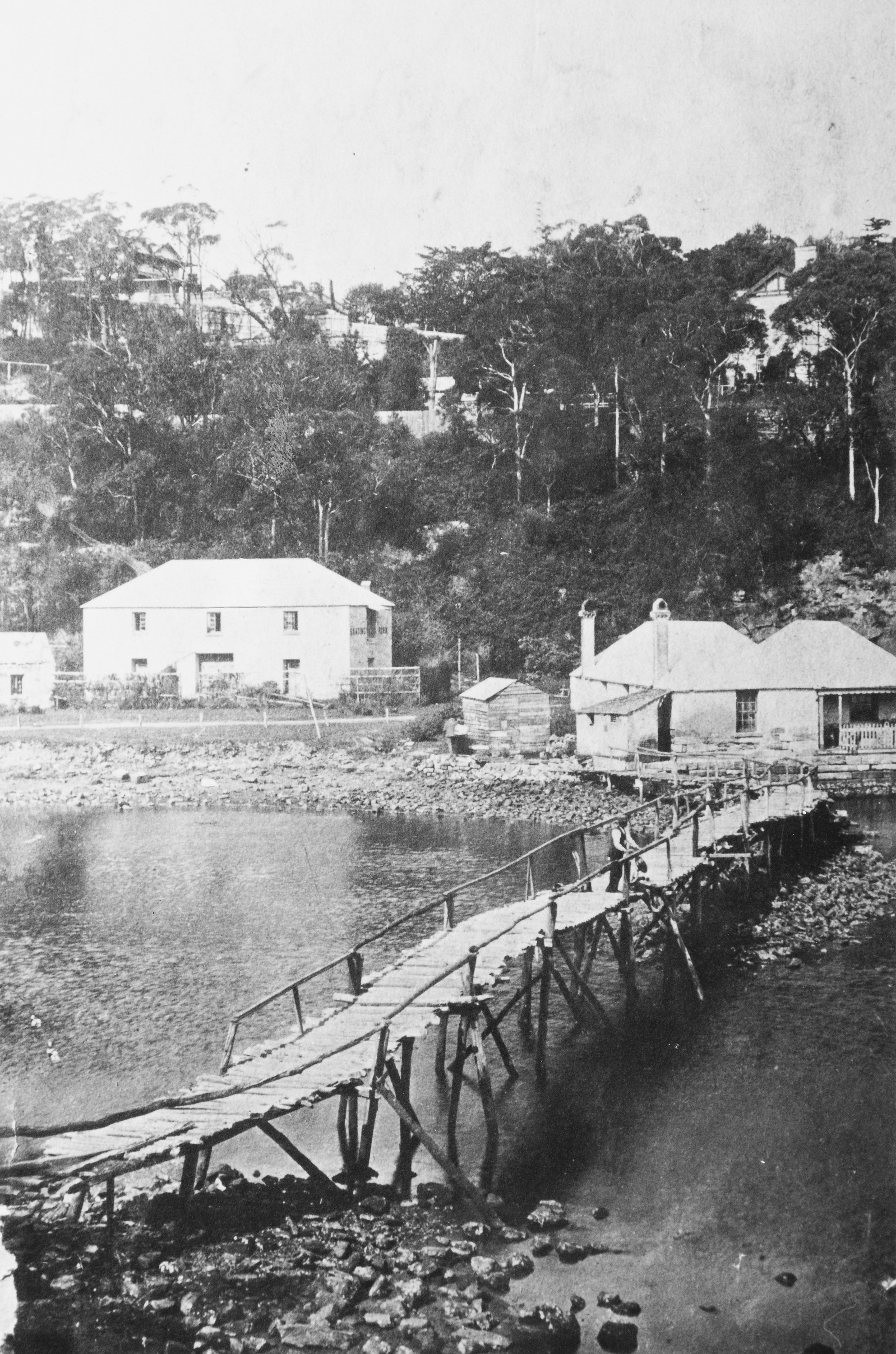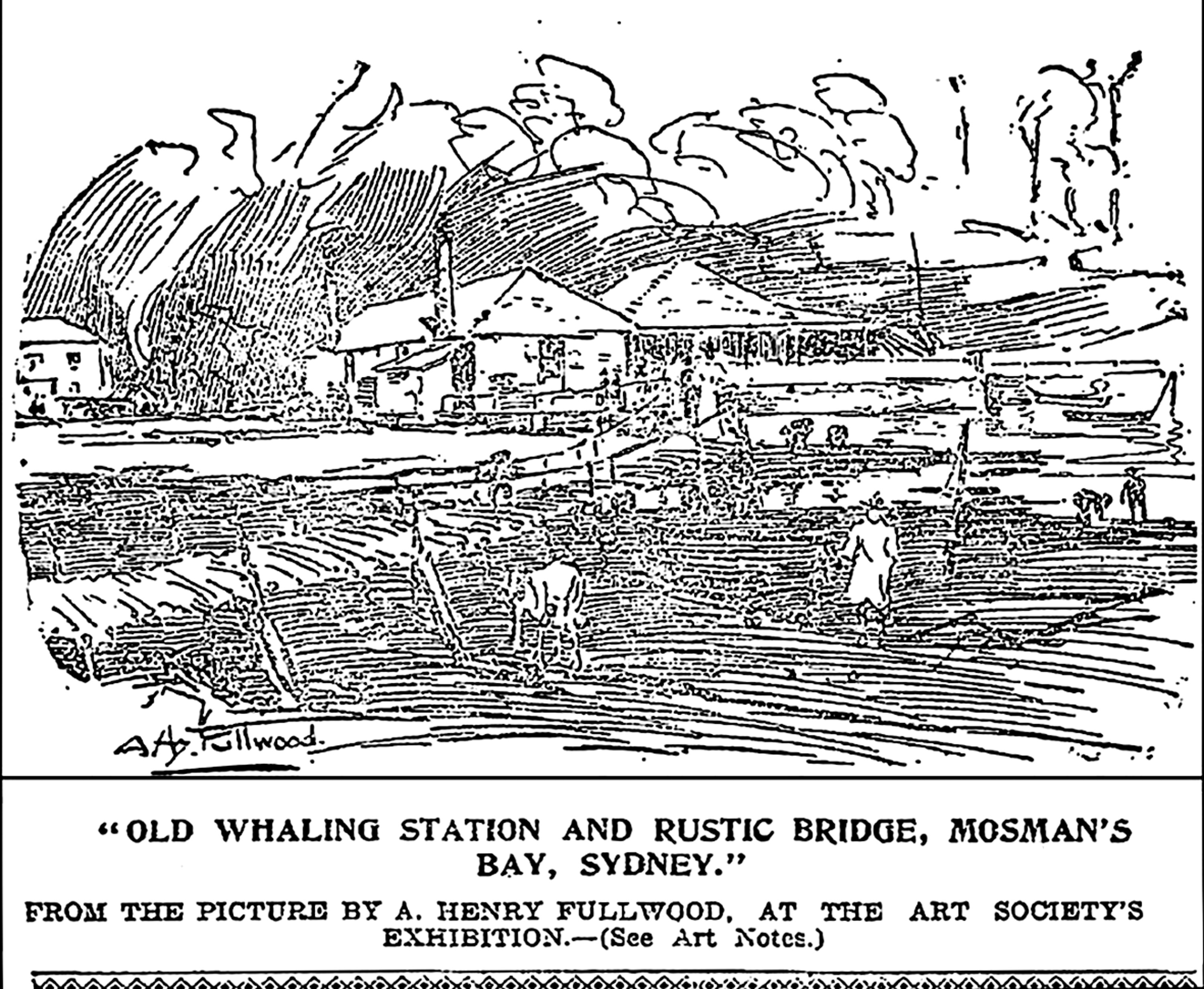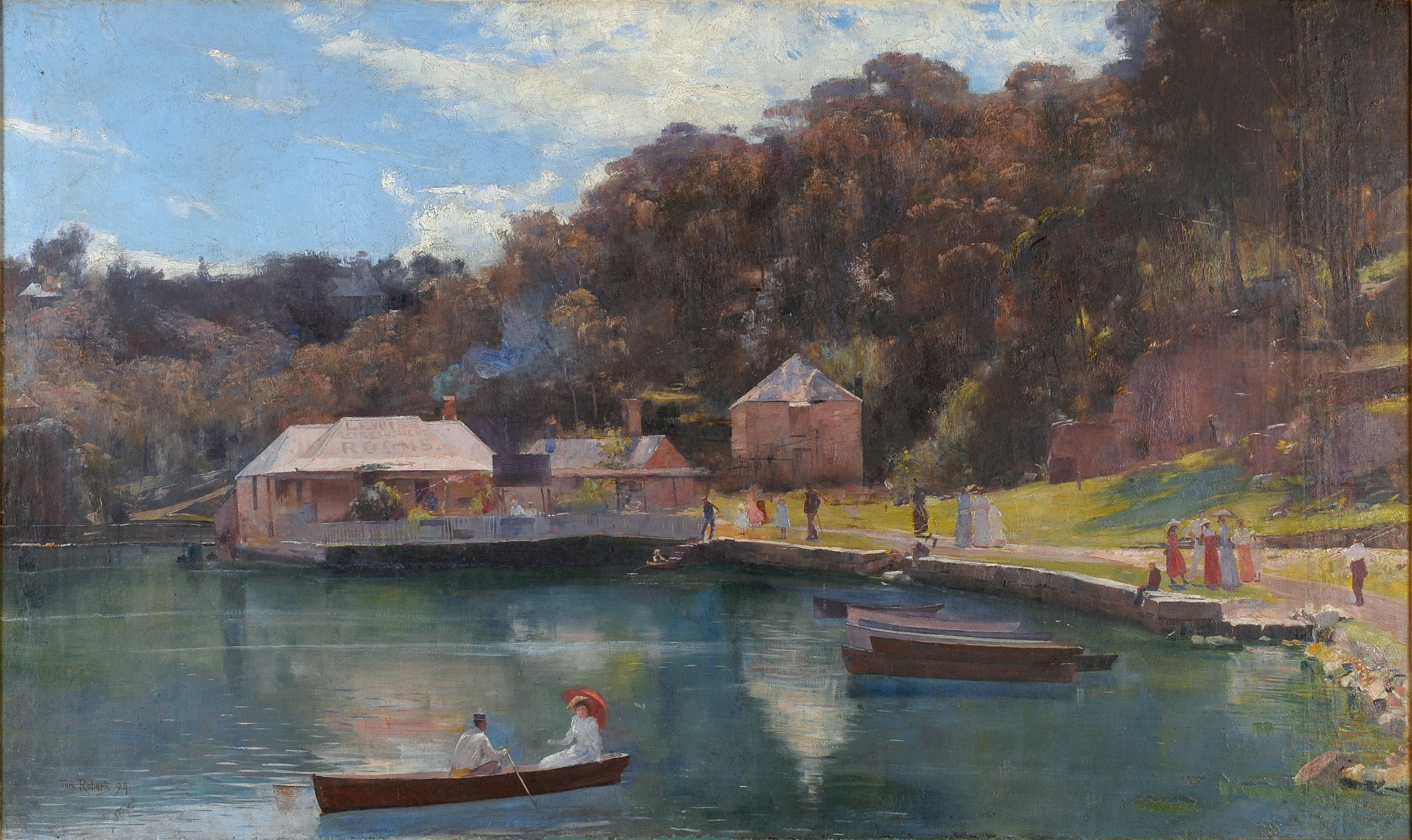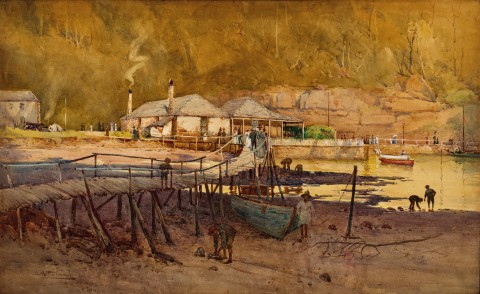THE OLD WHALING STATION, MOSMAN’S BAY, SYDNEY, 1899
ALBERT HENRY FULLWOOD
watercolour and gouache on paper on cardboard
57.5 x 94.0 cm (sight)
signed, dated and inscribed lower left: A. H. Fullwood. \ 99 / Old Bridge MOSMAN / Sydney
framer’s label attached verso: S. A. Parker, Sydney
bears inscription on framer’s label verso: A. H. Fullwood
The artist, Sydney
Thence by descent
Mrs V. Fullwood, Sydney, acquired from the above in 1930
Private collection, Melbourne
Private collection, Melbourne, acquired from the above in 2021
Spring Exhibition, Twentieth Annual Exhibition of the Royal Art Society of New South Wales, Royal Art Society of New South Wales, Sydney, 19 August – 20 September 1899, cat. 249 (as ‘The Old Whaling Station, Mosmans [sic.] Bay, Sydney’)
Second Federal Art Exhibition, South Australian Institute Building, Adelaide, 10 November – 9 December 1889 (as ‘The Old Whaling Station’)
(Studio exhibition), Paling’s Buildings, Sydney, 17 – 24 February 1900
Sydney Harbour: an exhibition to mark the 175th anniversary of the founding of Australia, Art Gallery of New South Wales, Sydney, 30 October – 19 November 1963, cat. 28 (label attached verso, as ‘Mossman’s [sic.] Bay’, loaned by Mrs. V. Fullwood)
‘The Art Societies. Preparations for August Shows’, The Daily Telegraph, Sydney, 31 July 1899, p. 3 (as ‘The Old Whaling Station at Mosman’s Bay’)
‘The Spring Art Exhibitions’, The Sydney Morning Herald, Sydney, 9 August 1899, p. 5 (as ‘Old Whaling Station’)
’This Year’s Pictures. The Annual Exhibitions’, The Australian Star, Sydney, 19 August 1899, p. 6 (as ‘The Old Whaling Station, Mosmans [sic.] Bay’)
‘The Art Exhibitions’, Sunday Times, Sydney, 20 August 1899, p. 10
’Art Society’s Show. Fine Landscape Display’, The Daily Telegraph, Sydney, 21 August 1899, p. 7 (illus., as ‘An Old Whaling Station, Mosman’s Bay’)
‘The Art Exhibitions. The Art Society’, Sydney Morning Herald, 22 August 1899, p. 3 (as ‘The Old Whaling Station, Mosman’s Bay’)
’Art Notes’, Sunday Times, Sydney, 3 September 1899, pp. 2, 9 (illus., as ‘Old Whaling Station and Rustic Bridge, Mosman’s Bay, Sydney)
‘Art in Adelaide. Second Federal Exhibition’, Quiz and the Lantern, Adelaide, 16 November 1899, p. 7 (as ‘The Old Whaling Station’)
The Studio (London), vol. XVII, no. 82, January 1900, p. 291 (illus.)
‘Mr. Fullwood’s Exhibition’, Sydney Morning Herald, Sydney, 17 February 1900, p. 5 (as ‘The rickety old footbridge at Mosman’s Bay’)
‘Mr. Fullwood’s Exhibition’, Evening News, Sydney, 20 February 1900, p. 6 (as ‘The Old Bridge at Mosman’s’)
‘Reviews’, The Mercury, Hobart, 28 February 1900, p. 5 (as ‘The Old Whaling Station’)
Souter, D. H., ‘A. Henry Fullwood, landscapist: being a review of his Australian work’, Art and Architecture: the Journal of the Institute of Architects of New South Wales, Sydney, vol. 3, no. 1 (January – February), 1905, pp. 5 (illus. as ‘Mosman’s Bay’), 6
Not Titled [Old Mosman whaling station], 1899, watercolour, gouache and ink on cardboard, 50.6 x 76.4 cm, in the collection of the National Gallery of Australia, Canberra
230002 High Res cymy FA.jpg

Mosman has long been one of Sydney’s favourite painting grounds. The artists who stayed at Bulletin cartoonist Livingstone Hopkins (‘Hop’)’s shack behind Edwards Beach in the 1880s (Julian Ashton, A.J. Daplyn, Frank Mahony and John Mather); the more celebrated residents of Reuben Brasch’s ‘Curlew Camp’ at Little Sirius Cove in the 1890s (Tom Roberts and Arthur Streeton); pioneer modernists (Elioth Gruner, Roland Wakelin and Margaret Preston); even Kevin Connor in the 1970s and Michael Johnson in the 1990s – all responded with delight to the sunshine, bright colour and varying distances of the North Shore littoral of Gorma Bullagong.1
For several decades from the 1820s Sirius Cove was a harbour for whaling vessels (it takes its present name from whaling station entrepreneur Alexander Mosman). But as early as the 1850s the area had become ‘a favourite place for picnickers … a beauty spot of the harbour,’ with ‘cheerful views and bracing breezes, secluded nooks with whispering seas and placid reflections.’2 Mosman provided all the seductions of bush and beach, and just a short ferry-ride from the city.
Mosman was also something of a heartland for A.H. Fullwood. While (like so many of his generation) Fullwood has been cast into the art-historical shadows by the quadrumvirate of Roberts, Streeton, Frederick McCubbin and Charles Conder, he was a prominent artist in Sydney during the 1880s and 1890s: as a black and white illustrator for the Picturesque Atlas of Australasia and for various newspapers and magazines, and as a sensitive and productive landscape painter in oils. Fullwood’s later work as an official artist during the Great War was celebrated in an exhibition at the Australian War Memorial in 1983, but only recently has Gary Werskey’s monograph given him the close attention he so warmly merits.3
Having migrated from Birmingham with his widowed mother and younger sisters in 1883, the talented Fullwood easily found work as a black and white artist in Sydney, but his fortunes faltered in the 1890s: he lost his savings in a run on the New South Wales Savings Bank in February 1892, around the same time that the illustrated papers – his bread-and-butter clients – were shifting from wood engravings to half-tone photographic reproduction. He appears to have joined his Australian naturalist colleagues Roberts and Streeton at Curlew Camp, where the rent was only six or seven shillings a week, before rejoining his family at ‘Yebrand’, a Mosman boarding house, in 1895. Married the following year, Fullwood nevertheless maintained the Mosman connection until his departure for London (via the USA) in 1899.
230002 option 1 FA.jpg

3 September 1899, p. 9
The present work is a superb example of the artist’s skill in that characteristic 19th century form, the highly-finished exhibition watercolour.4 A larger and more detailed version of a work formerly in the Oscar Paul Collection and now in the National Gallery of Australia, Canberra, The Old Whaling Station, Mosman’s Bay, Sydney depicts the view eastward across the head of Mosman’s Bay, from the shadowed mudflats of the foreground over opalescent water to the fashionable ‘refreshment rooms’, behind which rise pink sandstone cliffs and gold-green eucalyptus foliage. It combines dramatic landscape chiaroscuro, picturesque structures in the rickety old footbridge (soon to be replaced) and ‘The Barn’, as well as a host of narrative incidents: beachcombing boys; a man in white flannels and boater sitting on the wharf steps; a white tent on the sward centre left (pitched by artists, perhaps?)
The Old Whaling Station, Mosman’s Bay, Sydney also participates in the artistic conversation of its time: the horizonless plane of the bush background reprises Roberts’s Bailed Up, 1895 (Art Gallery of New South Wales, Sydney); the picnickers on the old footbridge are equivalent to the pier promenaders in Conder’s A Holiday at Mentone, 1888 (Art Gallery of South Australia, Adelaide); while the figure with the hitched-up skirt in the foreground irresistibly recalls the little girl in Julian Ashton’s The corner of the paddock, 1888 (National Gallery of Victoria, Melbourne).
230002 cmyk FA.jpg

First shown at the 1899 Society of Artists’ Annual (Spring) Exhibition, The Old Whaling Station, Mosman’s Bay, Sydney was widely applauded in contemporary press reviews. The Star called it ‘one of the most striking items in the water colour list’, while for the Sunday Times it was, of the 17 works Fullwood entered, his ‘best picture… The golden evening tints [morning, in fact] creep down the hills and across the old bridge till lost in the cold shadow of the foreground. A lad gathering oysters under the bridge, clever and complete. The best water-color [sic.] in the exhibition.’ The Telegraph declared it was ‘by far the best of its class in the whole show. There is vital human interest in this picture, as well as solid sterling craftsmanship.’5
The self-evident quality of the picture saw it included in the Second Federal Art Exhibition, Adelaide, and it was also reproduced not only in local papers and journals, but also in London’s Studio magazine. The Old Whaling Station, Mosman’s Bay, Sydney may not be by one of the ‘Australian Impressionist’ gods, nor be in the popularly valorised medium of oil paint, but this work is a remarkable achievement, a rich, complex piece of picture-making and a particularly fine example of fin-de-siècle watercolour.
1. A comprehensive listing of Mosman Bay pictures is beyond the scope of this entry, but amongst the finest and best-known 19th century pictures are: Conrad Martens, Mosman’s Bay, 1848, watercolour, State Library of New South Wales, Sydney; Julian Ashton, Mosman’s Bay, 1888, watercolour, Art Gallery of New South Wales, Sydney; John Mather, Mosman’s Bay, 1889, watercolour, 1889, AGNSW; Arthur Streeton, The Point Wharf, Mosman’s Bay, 1893, oil on canvas, National Gallery of Australia, Canberra; and Tom Roberts, Mosman’s Bay, 1894, New England Regional Art Museum, Armidale.
2. M.H., ‘Historic Memories. Mosman’s Bay. Forty Years Ago. Opening of Tram’, Evening News, 6 March 1897, p. 4; ‘Old Mosman’, Mosman Mail, 1 September 1899, p. 2
3. Anne Gray, A. Henry Fullwood: war artist, Canberra: Australian War Memorial, 1983; Gary Werskey, Picturing a nation: the art and life of A.H. Fullwood, NewSouth Books, Sydney, 2021
4. In the Society of Artists exhibition in which The Old Whaling Station, Mosman’s Bay, Sydney was first shown, there were 120 oil paintings and 135 watercolours, within a total of 294 works.
5. ‘This Year’s Pictures. The Annual Exhibitions’, Australian Star, Sydney, 19 August 1899, p. 6
DR DAVID HANSEN
